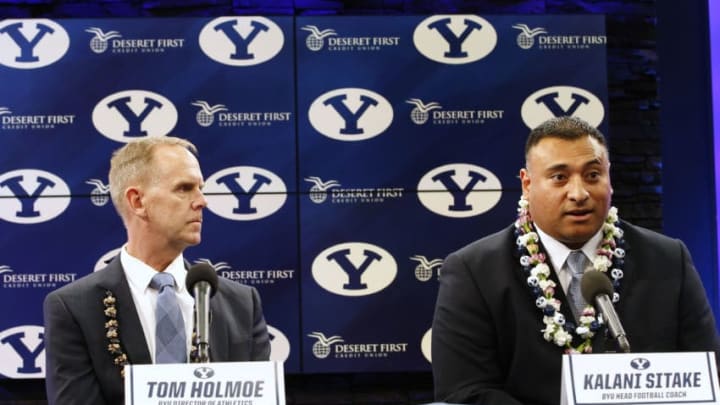When BYU football reached a deal with ESPN, most expected the Cougars to rake in money hand over fist. But a pamphlet mailed to Cougar Club members have some questioning the cash.
BYU football leaving the Mountain West, going Independent and signing a contract with ESPN are all good things. In fact, they’re all great things for the program.
Implying that the Cougars would be better off in the Mountain West conference is ridiculous. In fact, having BYU football move to a G5 conference – at least the way things currently stand – would be a pretty bad move.
The exposure BYU football gets by being Independent and by having the relationship with ESPN, is extremely valuable. The Cougars are making more than what G5 teams are making – even without knowing the exact details of BYU’s revenue we can be sure of that.
But a lot of BYU football fans had been under the impression that the revenue BYU was generating would be comparable to low-end P5 teams.
However, according to a document sent out to Cougar Club members, we may have a little better of an idea about BYU’s financial standings.
Here’s what the financial summary said:
BYU’s 2016 Operating Revenue
Donations and endowments: 22 percent
Football tickets: 20 percent
Tuition allocation: 14 percent
Sports camps: 8 percent
Men’s basketball tickets: 8 percent
Corporate sponsors: 7 percent
TV and radio: 7 percent
Other: 5 percent
Guarantees: 4 percent
NCAA/Conference: 4 percent
Other tickets: 1 percent
BYU’s 2016 Operating Expense
Salaries and benefits: 33 percent
Travel: 12 percent
Facilities and game expenses: 12 percent
Financial aid: 10 percent
Sports camps: 9 percent
Other: 6 percent
Gear and equipment: 5 percent
Housing and food: 4 percent
Marketing and fund raising: 4 percent
Guarantees: 3 percent
Recruiting: 2 percent
The Takeaways
Because BYU prefers to keep its finances close to the vest, it’s tough to know what those percentages work out to exactly. However, we can get a better idea about them by looking at BYU’s 2015 reporting to the US Department of Education.
According to that submission, BYU athletics generated a total revenue of $62,563,279. BYU’s grand total expenses was $54,429,683. That works out to about $8 million in revenue for the 2015 calendar year.
So, let’s take 2016’s TV/radio revenue (seven percent) and apply it to the 2015 total of $62,563,279.
Next: Check Out Jimmer's Awesome New Kicks
Seven percent of $62,563,279 is $4,379,429. Meaning that BYU made a little under $4.5 million from all TV and radio deals, including the ESPN contract.
Obviously, that’s not entire accurate, because things change from year to year. But it still lends us some insight.
The thing is, $4.5 million isn’t too shabby – but it certainly isn’t enough to hang with P5 teams long term. And it’s a far cry below what most expected from the deal when the reported figures were between $800,000-$1.2 million per ESPN aired home game.
For comparison, Utah made more than $5 million from Foster Farms Bowl/Pac-12 postseason distribution.
That’s why, ultimately, being Independent isn’t sustainable. The money gap between P5 and everyone else will only continue to grow. Sure, BYU might be in a better spot than G5 teams, but that won’t matter.
It’s not a particularly fun feeling to be desperate, but that’s where BYU has be to right now. They’ve got seven years to make a run at a P5 conference – and they have to get in. It’s fine to admit – it’s not like they’re the only ones.
For now (and the next six seasons), they have to keep winning. There needs to be an upset, there needs to be increased attention. When the TV deals expire and things realign, conference officials will be asking “what have you done lately?”
BYU football’s history of winning might not matter nearly as much.
